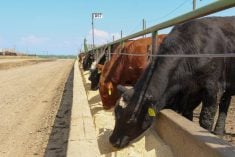During the week ending March 18, Alberta packers were buying fed cattle on a live basis at an average price of $205/cwt delivered, up $9/cwt from mid-February.
In the U.S., live cattle were trading in the range of US$164-US$165/cwt, up US$4/cwt from 30 days earlier. Beef demand typically makes a seasonal high in the latter half of March and first half of April. This year is no exception. U.S. feedlot operators have been active sellers at the higher levels.
Despite the year-over-year decline in market-ready fed cattle supplies, U.S. slaughter has been similar to a year ago. Packers on both sides of the border appear to have their nearby requirements covered.
Read Also

Harvest wraps up and fall work begins
At the Eppich famly ranch in western Saskatchewan, the fall harvest was successful with few breakdowns, cows and calves have been sorted and a new tractor has arrived
Longer term, the cattle market is vulnerable to additional downside potential as higher interest rates temper consumer spending. Higher interest rates are expected to cause the U.S. and Canadian economies to contract in the latter half of 2023.
The western Canadian feeder market has been trading near historical highs. Feed grain prices have softened over the past month and feeding margins have improved. However, weaker live cattle prices will weigh on the feeder cattle complex through the spring and summer.
U.S. cattle and calves on feed for slaughter as of Feb. 1, 2023 in feedlots with capacity of 1,000 or more head totalled 11.704 million head. This was down four per cent or 505,000 head from Feb. 1, 2022, inventory of 12.209 million head.

Placements have been running three to four per cent below a year ago. Therefore, market-ready fed cattle supplies will continue to be down from last year throughout 2023. Quarterly beef production during the second quarter of 2023 is expected to be down 400 million pounds from the second quarter of 2022. A similar year-over-year decline is expected in the third quarter.
In Western Canada
Cattle on feed in Alberta and Saskatchewan as of Feb.1, 2023 totalled 1.050 million head, down six per cent or 68,500 head from Feb. 1, 2022. Placements during January were 124,301 head, down five per cent or 6,613 head from January 2022. Market-ready fed cattle supplies have been similar to year-ago levels throughout the winter and early spring. This will change. Lower feedlot placements will eventually cause the Alberta fed cattle basis to strengthen. Recently, there has also been an increase in fed cattle exports to the U.S. Market-ready fed cattle supplies are expected to drop below last year in late spring and summer.
While beef supplies are down from a year ago, year-to-date demand has exceeded expectations. U.S. and Canadian restaurant traffic has been running above year-ago levels. Restaurant spending during March was estimated to be up 25 per cent from March, 2023. Average retail beef prices have also been slightly higher than a year ago. This is going to change.
Higher interest rates will cause the U.S. and Canadian economies to contract in the latter half of 2023. The U.S. is expected to lose about two million jobs, while Canada could shed 300,000 full-time positions by the end of the year. Business investment is slowing and inventory builds will decline. The main U.S. and Canadian equity indexes will probably drop by an additional 20 per cent from current levels. We could be heading into a financial crisis as banks come to terms with the higher-interest rate environment.
Are we at the top yet?
I’ve had a few calls from cattle producers asking how to know when the market has topped out. The commitments of traders report shows the length of the managed money and the commercial short position. When these positions are at extremes, it’s a fairly reliable signal that the top is near or in place. As of mid-March, the commercial short position was near 160,000 contracts. This tells us demand is full. Once the cup is full, it holds no more water. Market-ready supplies are down from last year but the weekly slaughter is near year-ago levels. Feedlot operators have saturated the market.
As of mid-March 2023, medium- to larger-frame, lower-flesh 800-pound steers were trading at $260/cwt in central Alberta. Tan steers averaging 600 pounds were quoted in the range of $300-$315/cwt. The feed grain markets have come under pressure over the past month and the deferred live cattle futures have been hovering around historical highs. The feeder market is somewhat vulnerable to weakness, with the live cattle futures experiencing demand jitters. I’ve been advising backgrounding operators and cow-calf producers to be more aggressive on purchasing price insurance. Markets don’t go up forever.
















